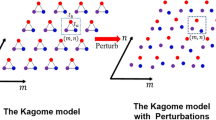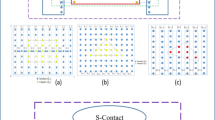Abstract
The efficient operation of organic electronic devices requires a high mobility of charge carriers in their active layers. According to modern concepts, the charge mobility in the best organic semiconductors is limited by dynamic disorder, i.e., fluctuations of intermolecular charge transfer integrals caused by the nonlocal electron–phonon coupling and thermal motion of molecules. However, the estimate of nonlocal electron–phonon coupling currently requires time- and resource-consuming methods, which complicates the search for high-mobility organic semiconductors among numerous candidates. In this work, a method has been proposed to rapidly estimate the lattice distortion energy, which is the main characteristic of the nonlocal electron–phonon coupling, by comparing the reorganization energies of molecules and molecular dimers. The determined lattice distortion energies are in good agreement with the values previously obtained by other methods. Furthermore, the proposed method has allowed addressing the effect of intermolecular delocalization on the nonlocal electron–phonon coupling. The results obtained indicate that the proposed approach is promising for the efficient search for organic semiconductors with a weak nonlocal electron–phonon coupling and a high charge mobility.
Similar content being viewed by others
References
E. A. Silin’sh, M. V. Kurik, and V. Chapek, Electronic Processes in Organic Molecular Crystals. Localization Phenomena and Polarities (Zinatne, Riga, 1988) [in Russian].
Y. Li, V. Coropceanu, and J.-L. Bredas, in Wspc Reference on Organic Electronics: Organic Semiconductors, Ed. by. S. R. Marder and J.-L. Bredas (World Scientific, Singapore, 2016), Chap. 7, p. 193.
V. Coropceanu, J. Cornil, D. A. da Silva Filho, Y. Olivier, R. Silbey, and J.-L. Bredas, Chem. Rev. 107, 926 (2007).
S. Fratini, S. Ciuchi, D. Mayou, G. Trambly de Laissardiere, and A. Troisi, Nat. Mater. 16, 998 (2017).
S. Fratini, D. Mayou, and S. Ciuchi, Adv. Funct. Mater. 26, 2292 (2015).
A. Troisi and G. Orlandi, J. Phys. Chem. A 110, 4065 (2006).
A. Y. Sosorev, D. R. Maslennikov, O. G. Kharlanov, I. Y. Chernyshov, V. V. Bruevich, and D. Y. Paraschuk, Phys. Status Solidi RRL 13, 1800485 (2019).
I. Y. Chernyshov, M. V. Vener, E. V. Feldman, D. Y. Paraschuk, and A. Y. Sosorev, J. Phys. Chem. Lett. 8, 2875 (2017).
T. Vehoff, B. Baumeier, A. Troisi, and D. Andrienko, J. Am. Chem. Soc. 132, 11702 (2010).
S. Illig, A. S. Eggeman, A. Troisi, L. Jiang, C. Warwick, M. Nikolka, G. Schweicher, S. G. Yeates, Y. H. Geerts, J. E. Anthony, and H. Sirringhaus, Nat. Commun. 7, 10736 (2016).
R. S. Sanchez-Carrera, P. Paramonov, G. M. Day, V. Coropceanu, and J. L. Bredas, J. Am. Chem. Soc. 132, 14437 (2010).
B. Kramer and A. Mackinnon, Rep. Prog. Phys. 56, 1469 (1993).
J. D. Picon, M. N. Bussac, and L. Zuppiroli, Phys. Rev. B 75, 235106 (2007).
A. Landi and A. Troisi, J. Phys. Chem. C 122, 18336 (2018).
A. Y. Sosorev, I. Y. Chernyshov, D. Y. Paraschuk, and M. V. Vener, in Molecular Spectroscopy: A Quantum Chemistry Approach, Ed. by. Y. Ozaki, M. J. Wojcik, and J. Popp (Wiley, Weinheim, 2019), Chap. 15, p. 425.
S. Larsson and A. Klimkåns, Mol. Cryst. Liq. Cryst. 355, 217 (2001).
A. Y. Sosorev, Phys. Chem. Chem. Phys. 19, 25478 (2017).
V. Coropceanu, R. S. Sanchez-Carrera, P. Paramonov, G. M. Day, and J.-L. Bredas, J. Phys. Chem. C 113, 4679 (2009).
A. Girlando, L. Grisanti, M. Masino, I. Bilotti, A. Brillante, R. G. Della Valle, and E. Venuti, Phys. Rev. B 82, 035208 (2010).
A. Girlando, L. Grisanti, M. Masino, A. Brillante, R. G. Della Valle, and E. Venuti, J. Chem. Phys. 135, 084701 (2011).
M. Valiev, E. J. Bylaska, N. Govind, K. Kowalski, T. P. Straatsma, H. J. J. Van Dam, D. Wang, J. Nieplocha, E. Apra, T. L. Windus, and W. A. de Jong, Comput. Phys. Commun. 181, 1477 (2010).
Cambridge Structural Database (CSD). https://doi.org/www.ccdc.cam.ac.uk/solutions/csdsystem/components/csd/.
B. Baumeier, J. Kirkpatrick, and D. Andrienko, Phys. Chem. Chem. Phys. 12, 11103 (2010).
J. Kirkpatrick, Int. J. Quant. Chem. 108, 51 (2008).
A. Y. Sosorev, D. R. Maslennikov, I. Y. Chernyshov, D. I. Dominskiy, V. V. Bruevich, M. V. Vener, and D. Y. Paraschuk, Phys. Chem. Chem. Phys. 20, 18912 (2018).
L. F. Ji, J. X. Fan, S. F. Zhang, and A. M. Ren, Phys. Chem. Chem. Phys. 20, 3784 (2018).
I. Yavuz, B. N. Martin, J. Park, and K. N. Houk, J. Am. Chem. Soc. 137, 2856 (2015).
L. Tang, M. Long, D. Wang, and Z. Shuai, Sci. China, Ser. B: Chem. 52, 1646 (2009).
Y. Yi, V. Coropceanu, and J.-L. Bredas, J. Chem. Phys. 137, 164303 (2012).
Acknowledgments
I am grateful to Prof. D.Yu. Paraschuk for stimulating discussions and valuable recommendations.
Funding
The development of the method was supported by the Russian Foundation for Basic Research (project nos. 16-32-60204 mol_a_dk and 18-52-45024). The quantumchemical calculations, as well as the formulation of the method for estimating the effect of delocalization on the nonlocal electron–phonon coupling, were supported by the Russian Science Foundation (project no. 18-72-10165).
Author information
Authors and Affiliations
Corresponding author
Additional information
Russian Text © The Author(s), 2019, published in Pis’ma v Zhurnal Eksperimental’noi i Teoreticheskoi Fiziki, 2019, Vol. 110, No. 3, pp. 171–177.
Electronic supplementary material
Rights and permissions
About this article
Cite this article
Sosorev, A.Y. Method for Fast Estimation of Lattice Distortion Energy in Organic Semiconductors. Jetp Lett. 110, 193–199 (2019). https://doi.org/10.1134/S0021364019150141
Received:
Revised:
Accepted:
Published:
Issue Date:
DOI: https://doi.org/10.1134/S0021364019150141




